
Care Tips: Can Gold Plated Jewelry Get Wet?
You should avoid wetting gold plated jewelry to maintain its shine and durability. Water exposure can lead to tarnishing, discoloration, and loss of the gold layer over time. To prevent damage, remove your jewelry before swimming or showering. Regularly wipe it with a soft cloth to keep it clean. If you want to learn more about how water affects gold plated jewelry and find effective care tips, continue exploring the information provided. Discover our Everyday Gold Jewelry collection, designed for durability and daily wear without compromising on style.
Understanding Gold Plating
If you've ever wondered how that shiny gold layer stays on your jewelry, understanding gold plating is key. Plating techniques involve electroplating a thin layer of gold onto a base metal. This creates the beautiful gold finish you see on your jewelry.
Care instructions for gold plated jewelry are essential to maintain its appearance. To keep your pieces looking their best, avoid exposing them to harsh chemicals like perfumes or lotions, as these can cause the gold plating to wear off faster. Additionally, it's best to remove gold plated jewelry before swimming or showering to prevent water damage.
When cleaning your jewelry, use a soft cloth to gently polish it, being careful not to scrub too hard and damage the delicate gold layer. By following these care instructions, you can enjoy your gold plated jewelry for years to come.
Effects of Water Exposure
When you expose your gold plated jewelry to water, there's a risk of tarnishing due to the metal's reaction with moisture. Additionally, frequent water exposure can affect the durability of the gold plating over time.
To maintain the shine and longevity of your jewelry, it's important to clean and dry it thoroughly after being exposed to water.
Tarnishing Risk Explained
Wondering why water exposure poses a risk of tarnishing your gold plated jewelry? When gold plated jewelry comes in contact with water, particularly if it's not water-resistant, the moisture can cause the thin layer of gold to wear off or tarnish more quickly. To prevent tarnishing, it is crucial to keep your gold plated jewelry as dry as possible and avoid prolonged exposure to water. Here's a simple breakdown of the effects of water exposure on gold plated jewelry:
Durability Concerns Addressed
To address durability concerns related to water exposure, it's important to understand how moisture affects the longevity of your gold plated jewelry. Gold plated jewelry is vulnerable to damage from water due to its thin layer of gold over a base metal. Moisture can cause the gold plating to wear off more quickly, leading to tarnishing and discoloration.
Applying waterproof sealants can provide some protection, but it's vital to note that these sealants may wear off over time and require reapplication. Manufacturers often conduct durability testing to determine the effectiveness of these sealants. Regular maintenance of the coating is also necessary to guarantee continued moisture protection.
Cleaning After Water Exposure
Addressing the effects of water exposure on your gold plated jewelry is crucial to maintaining its appearance and longevity. Guaranteeing proper cleaning after contact with water is essential. To ensure your jewelry retains its luster, gently clean it with a soft cloth after exposure to water. Avoid harsh chemicals or abrasive materials that could damage the delicate gold plating.
Additionally, consider using a mild soap and warm water solution to remove any residue from the jewelry. After cleaning, thoroughly dry your gold plated pieces using a soft, dry cloth to prevent water spots or tarnishing. For intricate designs or hard-to-reach areas, a soft-bristled toothbrush can be used with care.
Types of Water Exposure
Exposure to different types of water can impact the appearance and durability of your gold plated jewelry. It's important to be mindful of where and how your jewelry comes in contact with water to maintain its quality.
Here are some scenarios to contemplate:
- Rainy days: When caught in the rain, your jewelry may be exposed to rainwater, which is generally safe for gold plated pieces.
- Beach outings: Saltwater and sand can be harsh on gold plated jewelry, so it's best to avoid wearing it to the beach or make sure you rinse it thoroughly with fresh water after.
- Washing hands: Regular contact with soap and water from washing your hands is generally safe for gold plated jewelry, but drying it promptly can help maintain its shine.
- Doing dishes: The detergents and hot water used while doing dishes can be abrasive to gold plated jewelry. It's advisable to remove your jewelry before tackling the dishes to prevent damage.
Risks of Getting Wet
When it comes to your gold-plated jewelry, getting it wet can pose risks to its durability.
Prevent water damage by removing your jewelry before swimming, showering, or washing dishes.
After exposure, make sure to dry your pieces thoroughly to maintain their quality and shine.
Gold Plating Durability
To maintain the durability of gold-plated jewelry, it's essential to minimize its exposure to water. Gold plating longevity and water resistance can be greatly affected by moisture.
Here are some key points to keep in mind:
- Avoid Submerging: Refrain from wearing gold-plated jewelry when swimming, bathing, or doing dishes.
- Remove Before Activities: Take off your jewelry before engaging in activities that involve excessive sweating or contact with water.
- Dry Thoroughly: After any contact with water, make sure your jewelry is completely dry before storing it.
- Avoid Harsh Chemicals: Chemicals in water, like chlorine and salt, can speed up the tarnishing of gold plating.
Water Damage Prevention
Minimizing water exposure is key to protecting your gold-plated jewelry from potential damage, especially considering its impact on longevity and resistance to moisture. Gold-plated jewelry is susceptible to water damage due to the thin layer of gold on its surface.
To enhance its moisture resistance, consider using waterproof sealants specifically designed for jewelry. These sealants can provide an additional barrier against water and help maintain the shine and appearance of your gold-plated pieces.
Remember to remove your jewelry before activities involving water, such as swimming or showering, to prevent unnecessary exposure. By taking these precautions and utilizing waterproof sealants, you can extend the lifespan of your gold-plated jewelry and keep it looking its best.
Maintenance After Exposure
After your gold-plated jewelry has been exposed to water, promptly dry it with a soft cloth to prevent any potential damage. To guarantee the longevity of your jewelry, follow these maintenance steps:
- Air drying: After drying with a cloth, allow your jewelry to further air dry naturally. Avoid using heat sources as they can harm the gold plating.
- Quick cleaning: If there are water spots or residue left on the jewelry, promptly clean it with a jewelry cleaning cloth to prevent any tarnishing.
- Avoid harsh chemicals: Refrain from using strong chemicals or cleaning agents on your gold-plated jewelry as they can strip away the gold layer.
- Storage: Store your dried jewelry in a cool, dry place away from direct sunlight to prevent any further damage.
Showering With Gold Plated Jewelry
When wearing gold plated jewelry in the shower, remember to gently pat it dry afterward to prevent tarnishing. Gold plated jewelry can generally withstand occasional exposure to water, but it's important to take certain showering precautions to maintain its appearance. While gold plating does offer some water resistance properties, excessive exposure to water, soap, and shampoo can cause the plating to wear off more quickly.
To guarantee the longevity of your gold plated jewelry, avoid wearing it in the shower on a daily basis. The chemicals in soaps and shampoos can be harsh on the plating, leading to quicker tarnishing. Additionally, hot water can also speed up the fading process of the gold plating.
After showering with your gold plated jewelry, gently pat it dry with a soft cloth to remove any moisture. This simple step can help prevent water spots and tarnishing, keeping your jewelry looking its best for longer. Remember, taking these precautions can help maintain the beauty of your gold plated pieces.
Swimming and Water Sports
When swimming or engaging in water sports, remember that the durability of gold plating may be affected.
Chlorine, commonly found in pools, can cause your gold plated jewelry to tarnish more quickly.
Additionally, the effects of saltwater can also impact the appearance and longevity of your gold plated pieces.
Gold Plating Durability
To maintain the durability of gold-plated jewelry while engaging in swimming and water sports, it's important to follow proper care guidelines. Here are some tips to help preserve your jewelry's gold plating:
- Avoid Chemicals: Harsh chemicals in pools or saltwater can damage the gold plating.
- Dry Thoroughly: After water activities, make sure your jewelry is completely dry to prevent tarnishing.
- Store Properly: Store your gold-plated pieces in a jewelry box or pouch to protect them from moisture.
- Regular Cleaning: Gently clean your jewelry with a soft cloth to remove any residue and maintain its shine.
Chlorine Impact on Gold
Exposure to chlorine in swimming pools can accelerate the tarnishing of gold-plated jewelry, diminishing its luster over time.
To minimize the impact of chlorine on your gold-plated pieces, consider taking some precautions.
Before swimming, it's advisable to remove your jewelry to prevent direct contact with chlorine.
If you prefer to keep your jewelry on, make sure to rinse it thoroughly with clean water after leaving the pool.
Additionally, avoid wearing gold-plated jewelry while engaging in water sports to reduce its exposure to chlorine.
Saltwater Effects on Jewelry
Considering the impact of water on your gold-plated jewelry, it's important to be mindful of how exposure to saltwater during swimming and water sports can affect its quality and appearance. Here's how saltwater can impact your jewelry:
- Corrosion: Saltwater can cause the gold plating to corrode faster, leading to tarnishing and discoloration.
- Abrasion: The abrasive nature of saltwater can scratch the surface of your jewelry, dulling its shine.
- Build-up: Saltwater can leave behind residue on your jewelry, affecting its luster and overall look.
- Damage: Prolonged exposure to saltwater can weaken the metal underneath the gold plating, potentially causing it to break or chip.
When heading for a beach vacation or engaging in water sports, consider removing your gold-plated jewelry to keep it looking its best.
Cleaning After Water Contact
After water exposure, gently pat your gold plated jewelry dry with a soft cloth to prevent water stains and maintain its luster. It's crucial to dry any moisture promptly to avoid tarnishing or damage. Once you've dried the jewelry, consider using a jewelry polishing cloth to restore its shine. Additionally, inspect the piece for any signs of water damage, such as discoloration or dullness, and address them promptly.
To clean your gold plated jewelry after water contact, avoid using harsh chemicals or abrasive materials that can strip away the gold layer. Instead, opt for mild soapy water and a soft brush to gently clean the surface. After cleaning, ensure thorough drying before storing the jewelry to prevent any moisture buildup.
Regular maintenance is key to preserving the appearance of your gold plated jewelry. Consider applying a thin layer of clear nail polish to areas that come into direct contact with your skin to provide an extra barrier against moisture. By following these cleaning tips and maintenance advice, you can keep your gold plated jewelry looking radiant for longer.
Drying Techniques
To maintain the quality of your gold plated jewelry, make sure thorough and gentle drying after any contact with water. Proper drying techniques can prevent water stains and tarnishing. Here are some effective methods for drying your gold plated jewelry:
- Air drying: After rinsing your jewelry with water, lay it flat on a clean towel or cloth in a well-ventilated area. Allow it to air dry completely before storing or wearing it again.
- Towel blotting: Gently pat your jewelry with a soft, dry cloth or towel to absorb excess moisture. Avoid rubbing, as this can cause scratches or damage to the delicate gold plating.
- Avoid heat: Don't use a hairdryer or place your jewelry near direct heat sources like radiators, as high temperatures can cause the gold plating to fade or peel off.
- Use a jewelry polishing cloth: For a final touch, gently polish your dried gold plated jewelry with a jewelry polishing cloth to restore its shine and remove any remaining water marks.
Avoiding Chemical Reactions
To guarantee the protection of your gold plated jewelry, be cautious of chemical reactions that may occur when it comes into contact with certain substances. Chemical reactions can accelerate the oxidation process, causing your jewelry to tarnish more quickly. Avoid exposing your gold plated pieces to harsh chemicals such as chlorine, bleach, and sulfur, as these can strip away the gold layer.
Additionally, acidic substances like vinegar, lemon juice, or certain perfumes can also lead to discoloration and deterioration of the plating.
When cleaning your gold plated jewelry, opt for mild solutions like a mixture of warm water and gentle soap. Harsh cleaning agents can trigger chemical reactions that compromise the integrity of the plating. After cleaning, make sure your jewelry is completely dry before storing it to prevent any residual moisture from triggering oxidation processes.
Long-Term Care Strategies
When maintaining your gold plated jewelry for long-term use, incorporating regular care routines can help preserve its appearance and durability. To guarantee your jewelry stays in top condition, here are some essential long-term care strategies:
- Storage solutions: Keep your gold plated jewelry in airtight containers or zip-lock bags to prevent exposure to air, moisture, and sunlight, which can cause tarnishing and discoloration.
- Cleaning routines: Regularly cleanse your jewelry with a soft cloth or a mild soap solution to remove dirt, oils, and sweat that can accumulate over time and dull its shine.
- Preventing discoloration: Avoid exposing your gold plated jewelry to harsh chemicals, perfumes, and lotions, as these can cause the plating to fade or wear off faster.
- Polishing techniques: Use a jewelry polishing cloth or a gentle polishing solution specifically designed for gold plated jewelry to restore its luster and shine without damaging the delicate plating. Remember to be gentle and avoid abrasive materials that can scratch the surface.
Frequently Asked Questions
Can Gold Plated Jewelry Be Worn in the Ocean?
Yes, you can wear gold plated jewelry in the ocean. It's fine for pool parties and beach weddings. Just remember to rinse it with fresh water after to prevent tarnishing. Enjoy your ocean adventures worry-free!
Will Salt Water Damage Gold Plated Jewelry?
Salt water can damage gold plated jewelry. Avoid wearing it when showering or swimming in the ocean. Exposure to salt water, rain, and humidity can cause the plating to wear off quicker, leading to tarnishing.
Is It Safe to Wear Gold Plated Jewelry in Hot Tubs?
Wearing precautions are essential when it comes to hot tubs and gold plated jewelry. Avoid prolonged exposure to chemicals and water to maintain its shine. Regularly wipe dry and store properly to keep it looking its best.
How Often Should Gold Plated Jewelry Be Cleaned After Exposure to Water?
To maintain your gold plated jewelry's shine, clean it regularly after water exposure. Follow care instructions for proper maintenance. Cleaning frequency depends on usage; aim to clean it once a week with a gentle jewelry cleaner and soft cloth.
Can Gold Plated Jewelry Be Worn While Participating in Water Activities Like Surfing or Whitewater Rafting?
You can wear gold plated jewelry while showering or swimming, but avoid diving or snorkeling. Water exposure can tarnish it over time. Remember to gently pat it dry afterward to maintain its shine.
Conclusion
So, can gold plated jewelry get wet?
Yes, it can, but it's important to be cautious and take proper care. Water exposure can lead to tarnishing and damage over time.
Remember to remove your jewelry before activities like swimming or showering, and always dry it thoroughly afterwards.
By following these tips and taking preventative measures, you can help maintain the beauty and longevity of your gold plated pieces.





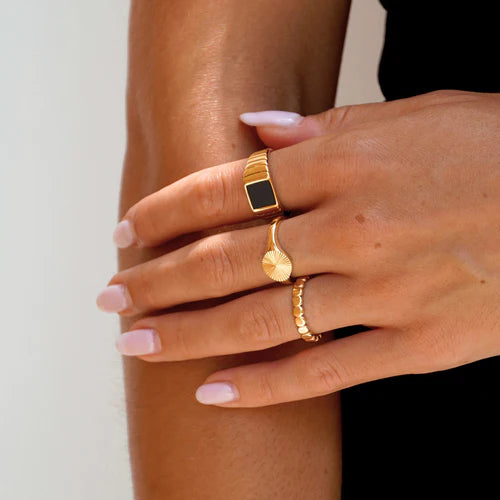



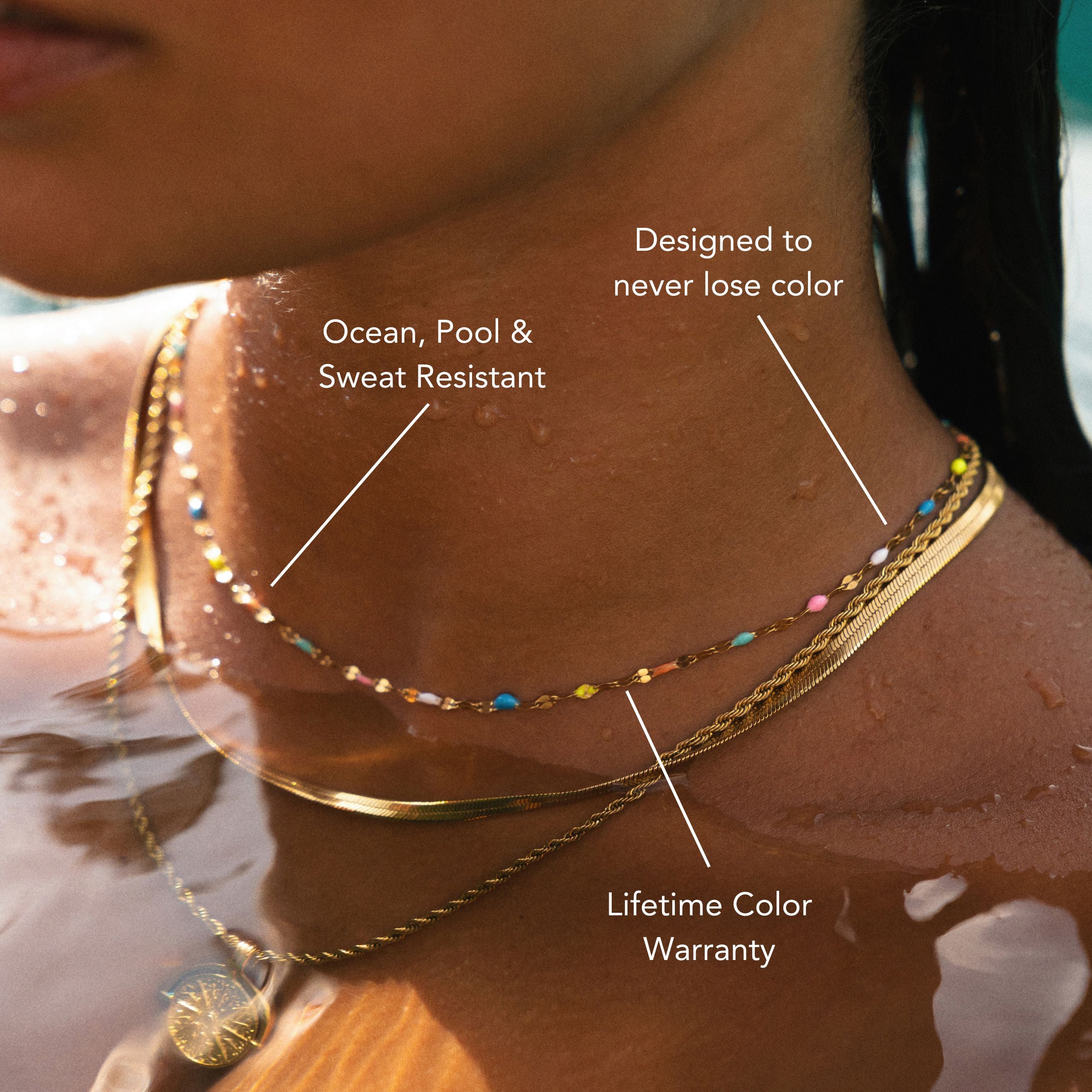
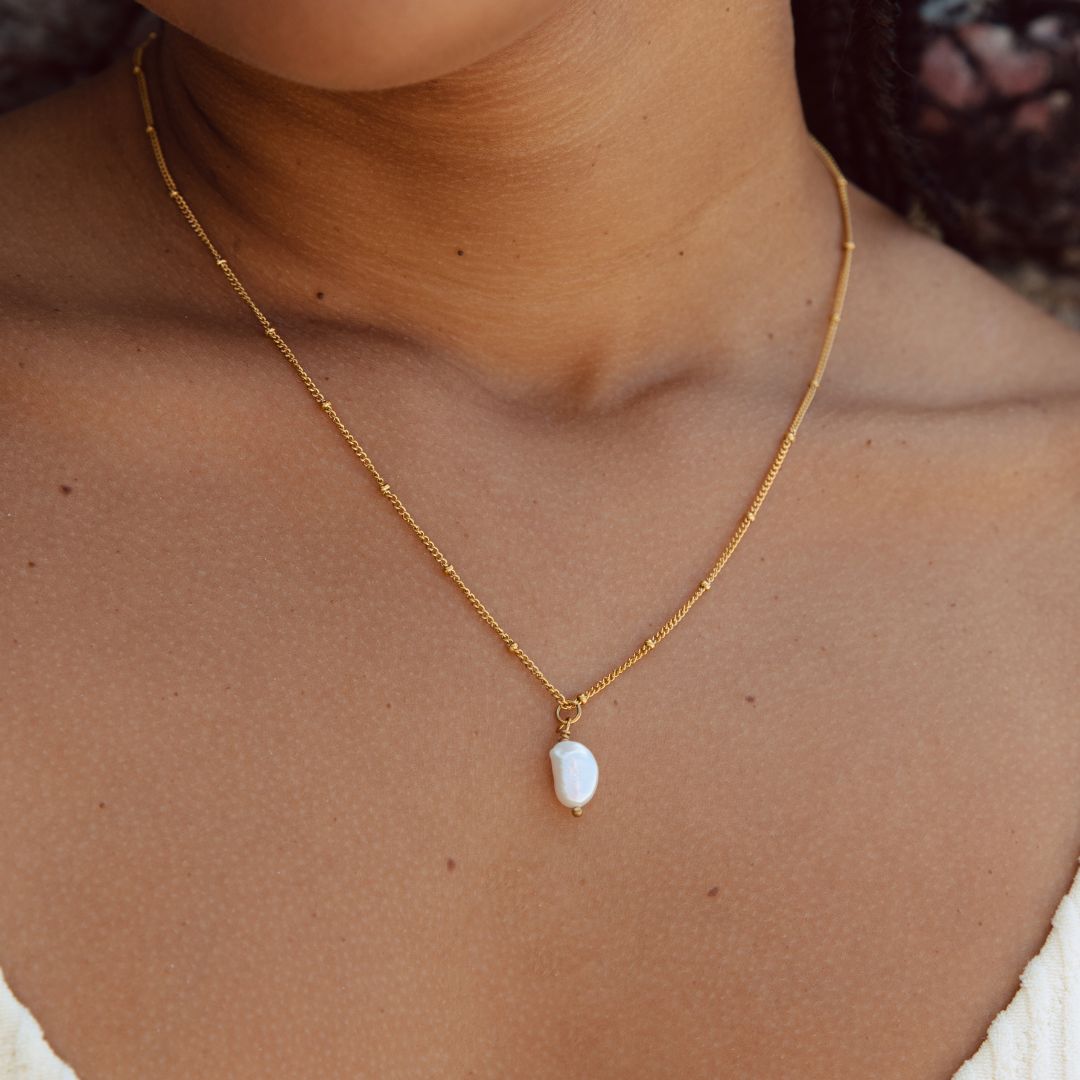
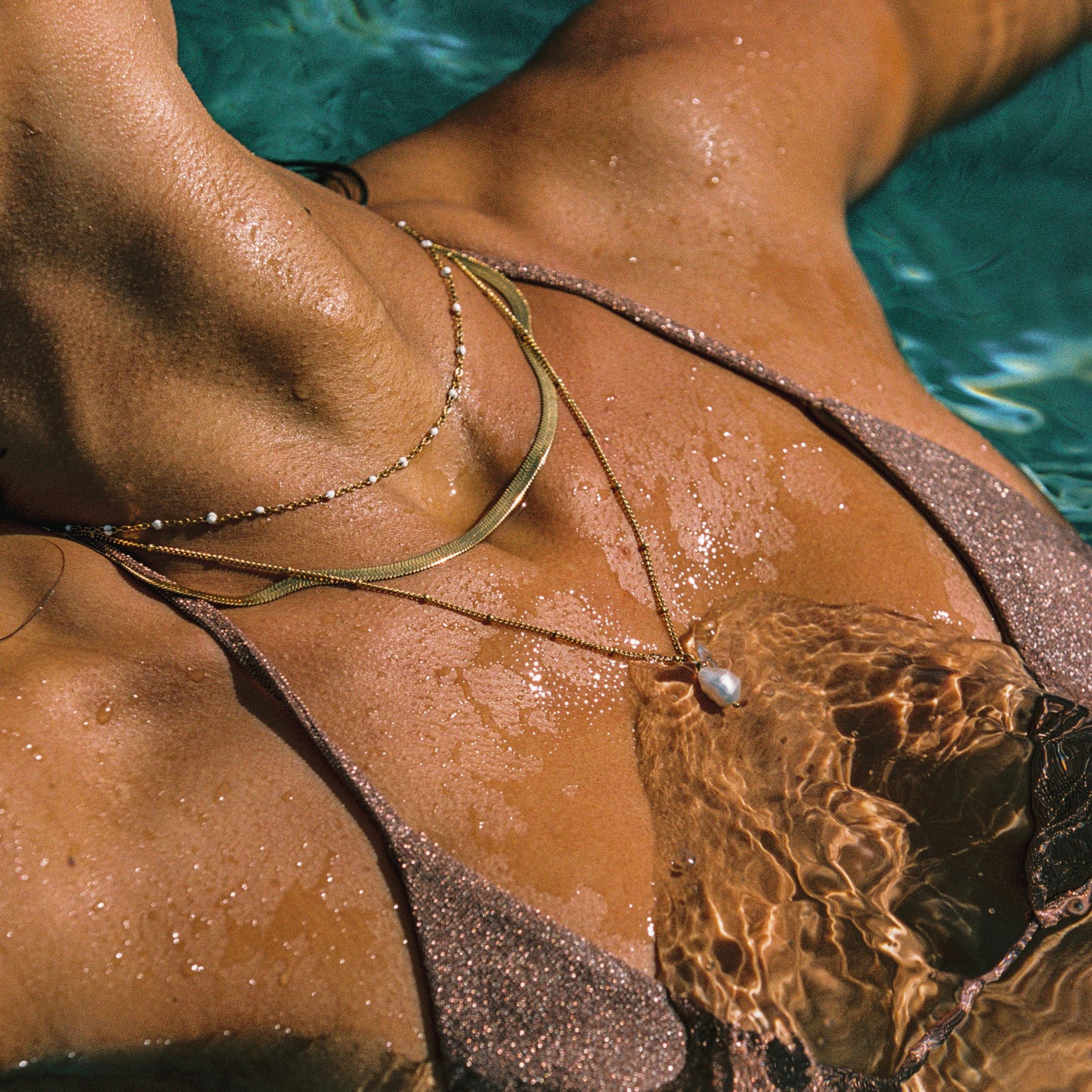
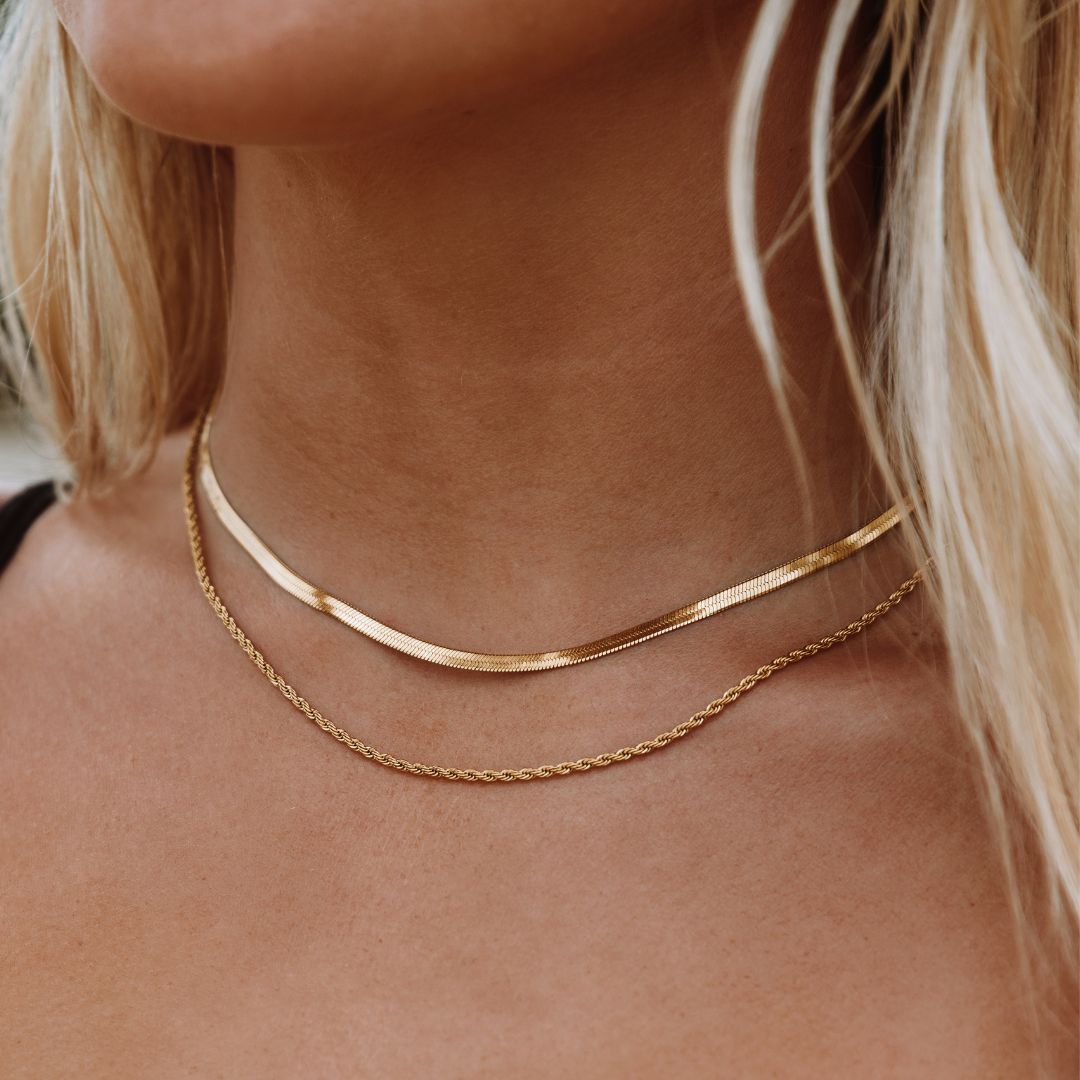



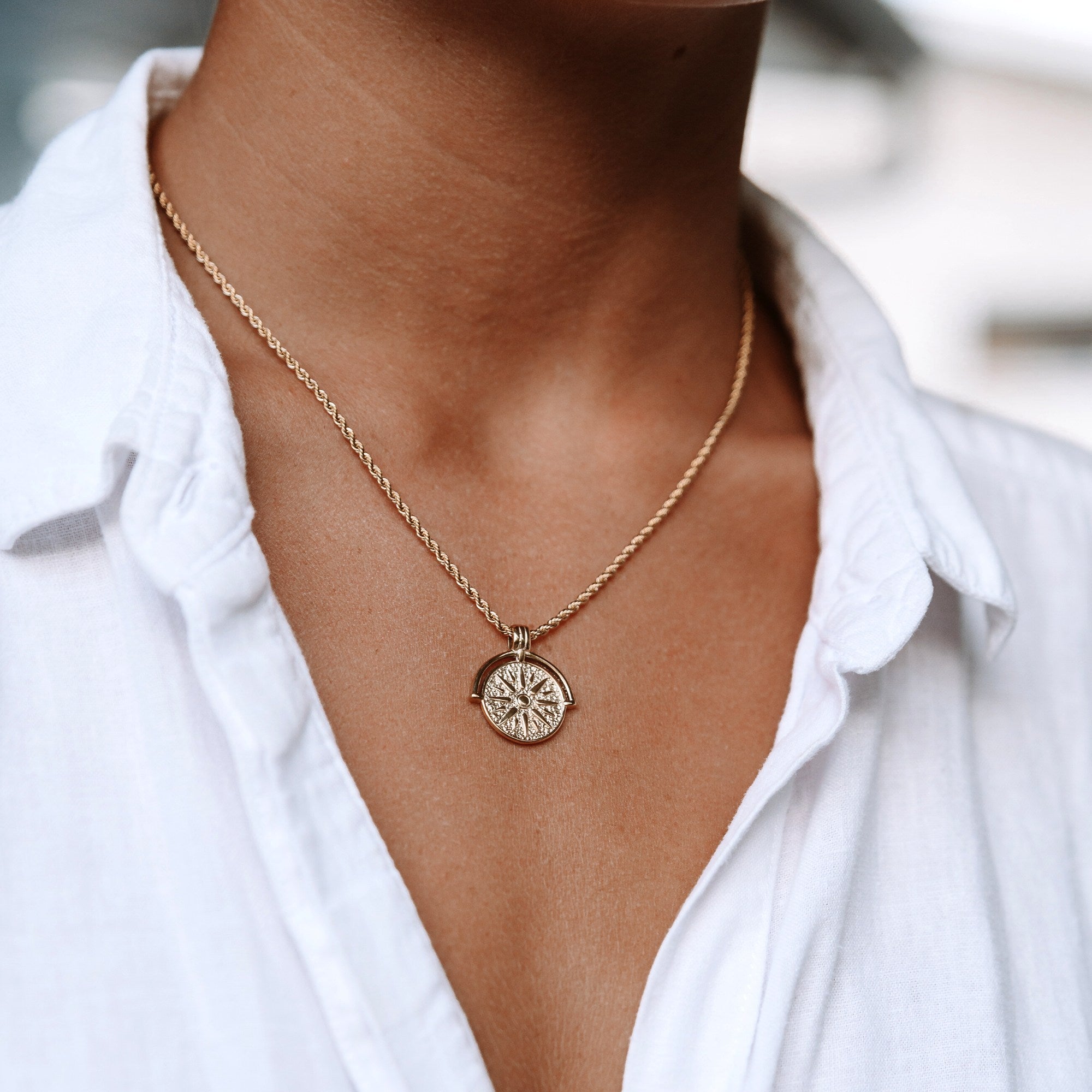







Leave a comment
This site is protected by hCaptcha and the hCaptcha Privacy Policy and Terms of Service apply.